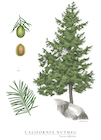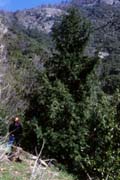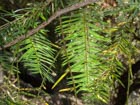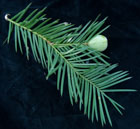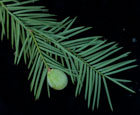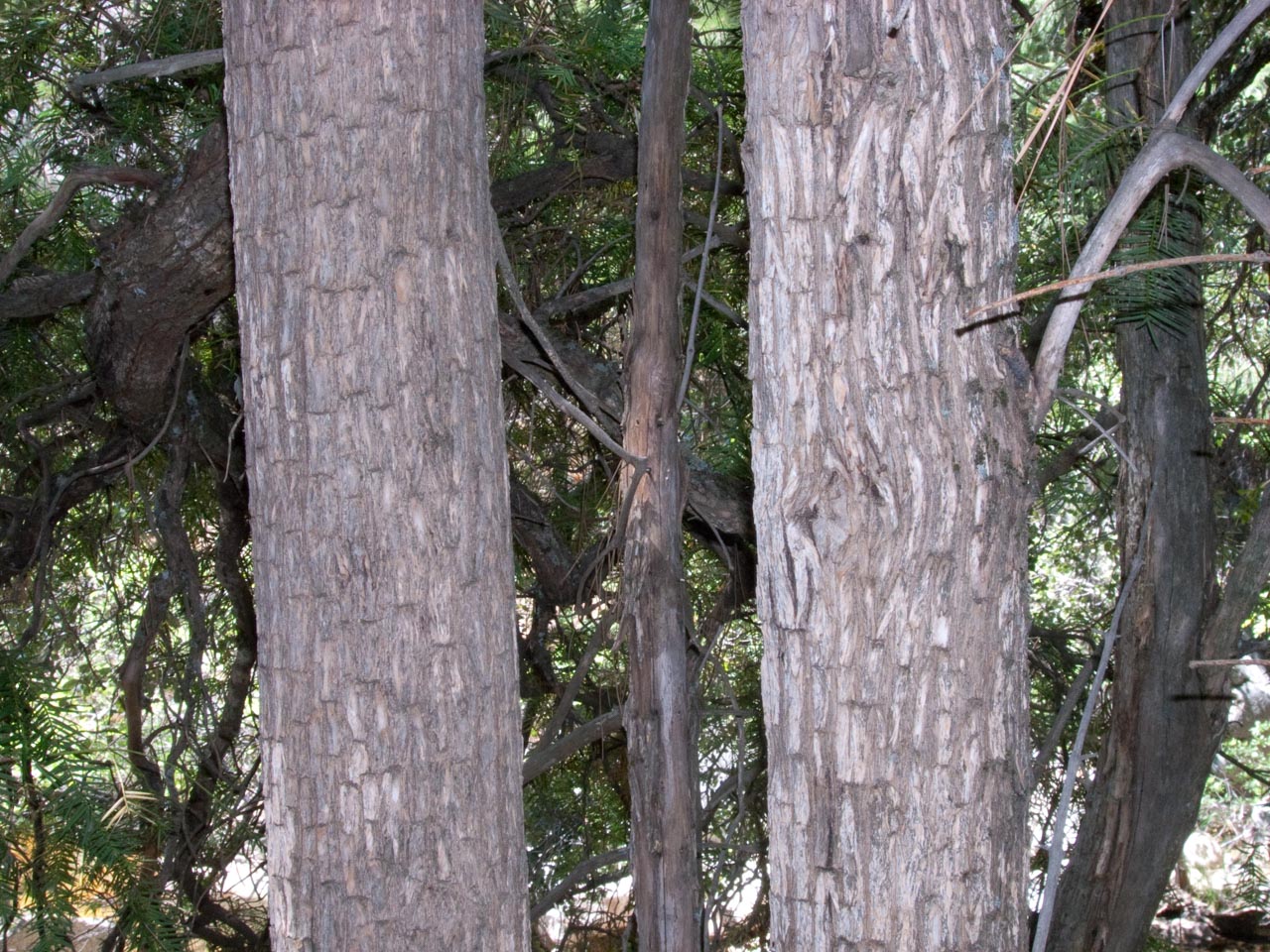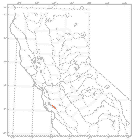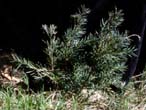Conservation Status

Torreya californica
Torrey 1854
Common names
California nutmeg, California torreya, stinking cedar (Peattie 1950).
Taxonomic notes
Syn: Torreya myristica Hooker; Tumion californicum (Torrey) Greene (Hils 1993).
Description
Dioecious shrubs or trees to 40 m tall and 120 cm dbh, forming a broad conical or rounded to irregular crown of spreading, drooping branches. Twigs with opposite branches, usually diverging horizontally at 40-60°, sometimes with more than 2 laterals from a node; slender, round, green turning reddish brown after 1 year, grooved along leaf bases. Buds terminal and very small, or at previous year's node and enlarged, broad-triangular, keeled, brown, deciduous. Leaves pectinate, spreading at 45-90° from the shoot, linear, 30-60 × 2.4-4.5 mm, straight or slightly falcate, with a twisted short petiole, abruptly wider at base, apex cuspidate, coriaceous, lustrous green above, with two pale green or glaucous stomatal bands on lower surface, 0.3-0.4 mm wide, separated by a midrib and bordered by raised, flat margins; stomata randomly distributed within the band. Leaves have a pungent odor when crushed. Pollen cones axillary, solitary, in short rows below lateral twigs, 5-6 × 4.5-5 mm, pale yellow at maturity. Seeds borne in axillary structures, solitary or paired, sessile, the ripe aril fleshy, smooth, pale or glaucous green with green to purplish longitudinal streaks, variably (ob)ovoid to broad-elliptic, 25-35 × 25 mm. 2n = 16 (Hils 1993, Farjon 2010). See García Esteban et al. (2004) for a detailed characterization of the wood anatomy.
Distribution and Ecology
USA: California. Rare and local along mountain streams, protected slopes, creek bottoms, and moist canyons of the Coast Range and Sierra Nevada, at 0-2000 m elevation (Hils 1993). It occurs in a wide variety of vegetation associations; in the Coast Ranges, it grows in chaparral and redwood (Sequoia sempervirens) forest. In both coastal and inland areas it grows with canyon live oak (Quercus chrysolepis) and California bay. Inland populations are
most commonly found in the ponderosa pine (Pinus ponderosa) belt, and occasionally in chaparral communities of the Cascade-Sierra Nevada (Howard 1992). Hardy to Zone 7 (cold hardiness limit between -17.7°C and -12.2°C) (Bannister and Neuner 2001). See also Thompson et al. (1999).
Distribution data from USGS (1999). Points plotted as tree icons represent isolated or approximate locations.
The California Torreya is assessed as "vulnerable" due to historical logging that has virtually eliminated it in parts of its historic range, and has removed most large trees across almost all of its range (Farjon 2013). Logging during the early 1900's eliminated California nutmeg from the Vaca Mountains of Napa and Solano counties, and considerably reduced populations in the Santa Cruz Mountains and lower Russian River area of Sonoma County (Burke 1975). Regrowth is reported to be very slow. A decline of more than 50% of mature trees in the population has been inferred over the past 150 years (three generations) (Farjon 2013).
Remarkable Specimens
A tree in Big Basin State Park, 107.5 cm DBH and 32.0 m tall, measured 2013, is currently listed as the U.S. national champion (UFEI 2017). A tree 123 cm DBH was recorded at the Castlewellan National Arboretum at the U.K. in 2000, but its current status is unknown (Monumental Trees 2014). A tree near Swanton, California, was 203.7 cm DBH and 29.3 m tall when measured in 1992, but it fell in 2011 (F. Callahan email 2014.10.01). The largest on record, though, was a tree growing near Fort Bragg that measured 43 m tall and 450 cm dbh; it was cut by timber thieves (Murray 1985).
The oldest known is represented by a disk from a tree that was logged from a dry south slope in a canyon west of Willits, California. It contains 480 rings in a distance of about 45 cm. The disk is owned by Frank Callahan (email 2011.08.21), who also has another disk from a former national champion tree (noted above) that has 286 rings.
Ethnobotany
Currently, this is the most popular Torreya in ornamental use worldwide, especially in large gardens where it can grow into a substantial tree (Farjon 2013). The fine-grained yellow-brown wood is attractive and of good quality. It is strong and elastic, smooth in texture, polishes well, and has a fragrance similar to that of sandalwood. Historically, the rot-resistant wood was logged, especially in the redwood country, and its very rot-resistant wood was used for making cabinets, turned items, and novelty items; and for fuel, fenceposts, and bridges (Burke 1975). Aboriginal uses included bows (Peattie 1953). The Costanoan Indians would smash the nuts and rub on their body to treat headaches or chills, or to cause sweating; the nuts would be chewed to treat indigestion. The Pomo Indians made a decoction of the nuts to treat tuberculosis, used the roots as splints in baskets, used the leaves as tattoo needles (various sources cited in the Native American Ethnobotany Database, accessed 2022.12.15).
Observations
Reported readily-accessible locations include the following:
Yosemite National Park: Arno and Gyer (1973) indicate that it can be found along the road entering Yosemite Valley from El Portal. I have also seen it near Cascade Falls on the Big Oak Flat Road.
Sequoia-Kings Canyon National Park: I have found it on the road towards Giant Forest a few miles beyond the Foothills Visitor Center (36° 32.558' N, 118° 46.912' W). My notes report: "Here I find what is definitely the most prickly conifer I have ever encountered. This They're growing amidst evergreen oaks, blue oaks, tanoak, a few small incense-cedars, and an understory with a xeric analogue of ladyfern, shrub oak, and probably poison oak. There's active regeneration, trees and seedlings growing both above and below the highway. Within 100 m of the sample point there are probably 50 stems taller than breast height, the largest has a dbh of about 25 cm. These trees are growing on a south- or southeast-facing slope. It seems to be a relatively dry microsite, but the torreyas are on locally concave topography. Slopes are 60-70%. We only find fruits on the largest, sun-grown specimen. Seedlings, of which the smallest I can find are about 15 cm tall, basically look the same as the larger plants except that their needles are shorter, about 1.5-2 cm vs. 4 cm on sun foliage in the mature trees." I also have a report that they occur in Sequoia National Park on the lower part of the trail from Potwisha campground to Marble Falls (Roy Malahowski email 2011.03.13), and Arno and Gyer (1973) state it can be found at the entrance to Boyden Cave in Kings Canyon and along the trail to Crystal Cave and near Clough Cave in Sequoia National Park.
California coastal parks: Arno and Gyer (1973) indicate that it can be found in "draws and basins on Mt. Tamalpais in Marin County." Samuel P. Taylor State Park near Point Reyes has some very large trees, including two that were 30.25 and 32.3 m tall in November 2011 (Steve Sillett email 2011.11.19). The trees can also be found, at an unusually low, dry location, on the trails of Low Gap Park in Ukiah (Mark Hedden email 2017.07.10).
Remarks
The epithet refers to California, where this species is endemic.
Citations
Arno, Stephen F. and Jane Gyer. 1973. Discovering Sierra trees. Yosemite Natural History Association. 89pp.
Burke, J. G. 1975. Human use of the California nutmeg tree, Torreya californica, and other members of the genus. Economic Botany 29:127-139.
Howard, Janet L. 1992. Torreya californica. In: Fire Effects Information System. U.S. Department of Agriculture, Forest Service, Rocky Mountain Research Station, Fire Sciences Laboratory. Available:
https://www.fs.usda.gov/database/feis/plants/tree/torcal/all.html, accessed 2022.12.15.
Monumental Trees. 2014. The thickest, tallest, and oldest California torreya trees (Torreya californica). www.monumentaltrees.com/en/trees/torreyacalifornica/records/, accessed 2014.10.12.
Murray, M. D. 1985. The California nutmeg. American Forests 91:40-51.
Peattie, D. C. 1953. A natural history of western trees. Boston, MA: Houghton Mifflin Co. 751 p.
Torrey, J. 1854. Notice of the "California Nutmeg". New York Journal of Pharmacy 3: P. 49-51.
Urban Forests Ecosystem Institute (UFEI). 2017. California Nutmeg - Torreya californica. https://californiabigtrees.calpoly.edu/tree-detail/torreya-californica/396, accessed 2019.03.01.
See also
Burke (1975).
Elwes and Henry 1906-1913 at the Biodiversity Heritage Library. This series of volumes, privately printed, provides some of the most engaging descriptions of conifers ever published. Although they only treat species cultivated in the U.K. and Ireland, and the taxonomy is a bit dated, still these accounts are thorough, treating such topics as species description, range, varieties, exceptionally old or tall specimens, remarkable trees, and cultivation. Despite being over a century old, they are generally accurate, and are illustrated with some remarkable photographs and lithographs.
Lanner (1999).
Stein, W.I. 2008. Torreya Arn. torreya. Pp. 1121-1124 in Woody Plant Seed Manual, USDA Forest Service, https://www.fs.usda.gov/nsl/Wpsm/Torreya.pdf, accessed 2022.12.19, provides useful information on propagation.
Threatened Conifers of the World.
